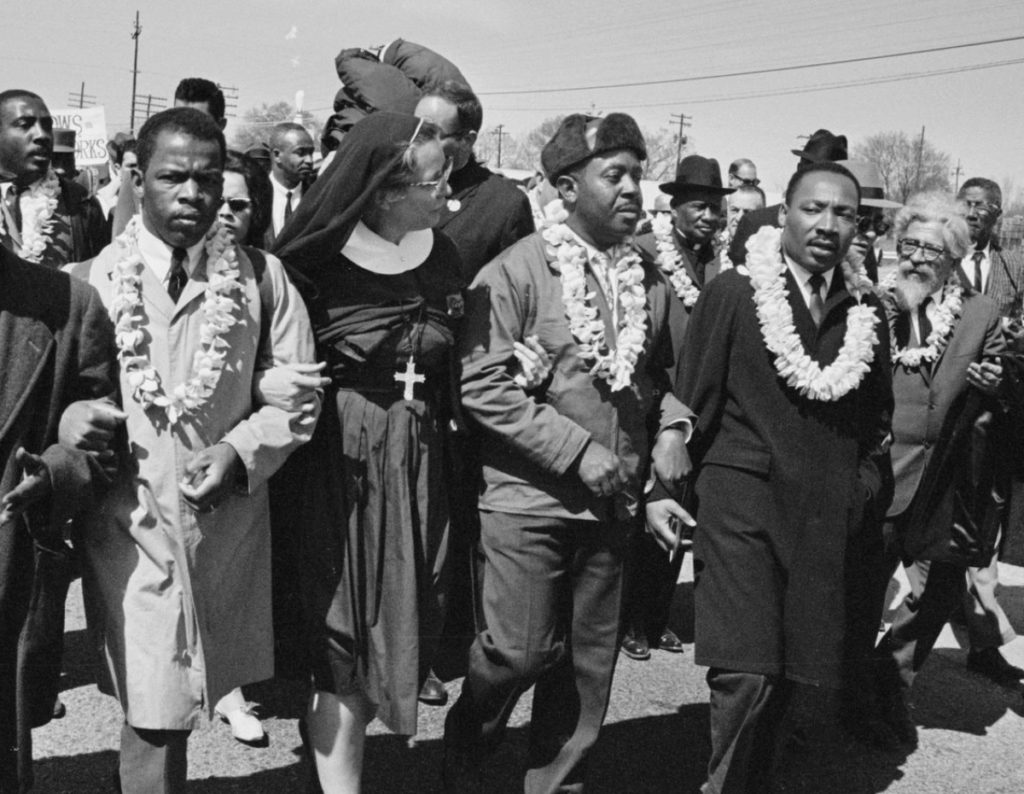
Mr. Lewis, left, marching with the Rev. Dr. Martin Luther King Jr., right, from Selma to Montgomery, Ala., on March 21, 1965.Credit…William Lovelace/Daily Express, via Getty Images
“Do not get lost in a sea of despair. Be hopeful, be optimistic. Our struggle is not the struggle of a day, a week, a month, or a year, it is the struggle of a lifetime. Never, ever be afraid to make some noise and get in good trouble, necessary trouble.”
–John Lewis
By Katharine Q. Seeyle, New York Times
Representative John Lewis, a son of sharecroppers and an apostle of nonviolence who was bloodied at Selma and across the Jim Crow South in the historic struggle for racial equality, and who then carried a mantle of moral authority into Congress, died on Friday, July 17. He was 80. …
On the front lines of the bloody campaign to end Jim Crow laws, with blows to his body and a fractured skull to prove it, Mr. Lewis was a valiant stalwart of the civil rights movement and the last surviving speaker from the March on Washington for Jobs and Freedom in 1963.
More than a half-century later, after the killing in May of George Floyd, a Black man in police custody in Minneapolis, Mr. Lewis welcomed the resulting global demonstrations against police killings of Black people and, more broadly, against systemic racism in many corners of society. He saw those protests as a continuation of his life’s work, though his illness had left him to watch from the sidelines.
“It was very moving, very moving to see hundreds of thousands of people from all over America and around the world take to the streets — to speak up, to speak out, to get into what I call ‘good trouble,’” Mr. Lewis told “CBS This Morning” in June.
He died on the same day as another civil rights stalwart, the Rev. C.T. Vivian, a close associate of the Rev. Dr. Martin Luther King Jr.
Mr. Lewis’s personal history paralleled that of the civil rights movement. He was among the original 13 Freedom Riders, the Black and white activists who challenged segregated interstate travel in the South in 1961. He was a founder and early leader of the Student Nonviolent Coordinating Committee, which coordinated lunch-counter sit-ins. He helped organize the March on Washington, where Dr. King was the main speaker, on the steps of the Lincoln Memorial.
Mr. Lewis led demonstrations against racially segregated restrooms, hotels, restaurants, public parks and swimming pools, and he rose up against other indignities of second-class citizenship. At nearly every turn he was beaten, spat upon or burned with cigarettes. He was tormented by white mobs and absorbed body blows from law enforcement.
On March 7, 1965, he led one of the most famous marches in American history. In the vanguard of 600 people demanding the voting rights they had been denied, Mr. Lewis marched partway across the Edmund Pettus Bridge in Selma, Ala., into a waiting phalanx of state troopers in riot gear.
Ordered to disperse, the protesters silently stood their ground. The troopers responded with tear gas and bullwhips and rubber tubing wrapped in barbed wire. In the melee, which came to be known as Bloody Sunday, a trooper cracked Mr. Lewis’s skull with a billy club, knocking him to the ground, then hit him again when he tried to get up.
Televised images of the beatings of Mr. Lewis and scores of others outraged the nation and galvanized support for the Voting Rights Act, which President Lyndon B. Johnson presented to a joint session of Congress eight days later and signed into law on Aug. 6. A milestone in the struggle for civil rights, the law struck down the literacy tests that Black people had been compelled to take before they could register to vote and replaced segregationist voting registrars with federal registrars to ensure that Black people were no longer denied the ballot. …
Mr. Lewis was arrested 40 times from 1960 to 1966. He was repeatedly beaten senseless by Southern policemen and freelance hoodlums. During the Freedom Rides in 1961, he was left unconscious in a pool of his own blood outside the Greyhound Bus Terminal in Montgomery, Ala., after he and others were attacked by hundreds of white people. He spent countless days and nights in county jails and 31 days in Mississippi’s notoriously brutal Parchman Penitentiary. …
His family called him “Preacher,” and becoming one seemed to be his destiny. He drew inspiration by listening to a young minister named Martin Luther King on the radio and reading about the 1955-56 Montgomery bus boycott. He finally wrote a letter to Dr. King, who sent him a round-trip bus ticket to visit him in Montgomery, in 1958. By then, Mr. Lewis had begun his studies at American Baptist Theological Seminary (now American Baptist College) in Nashville, where he worked as a dishwasher and janitor to pay for his education.
To read the entire story, click HERE
